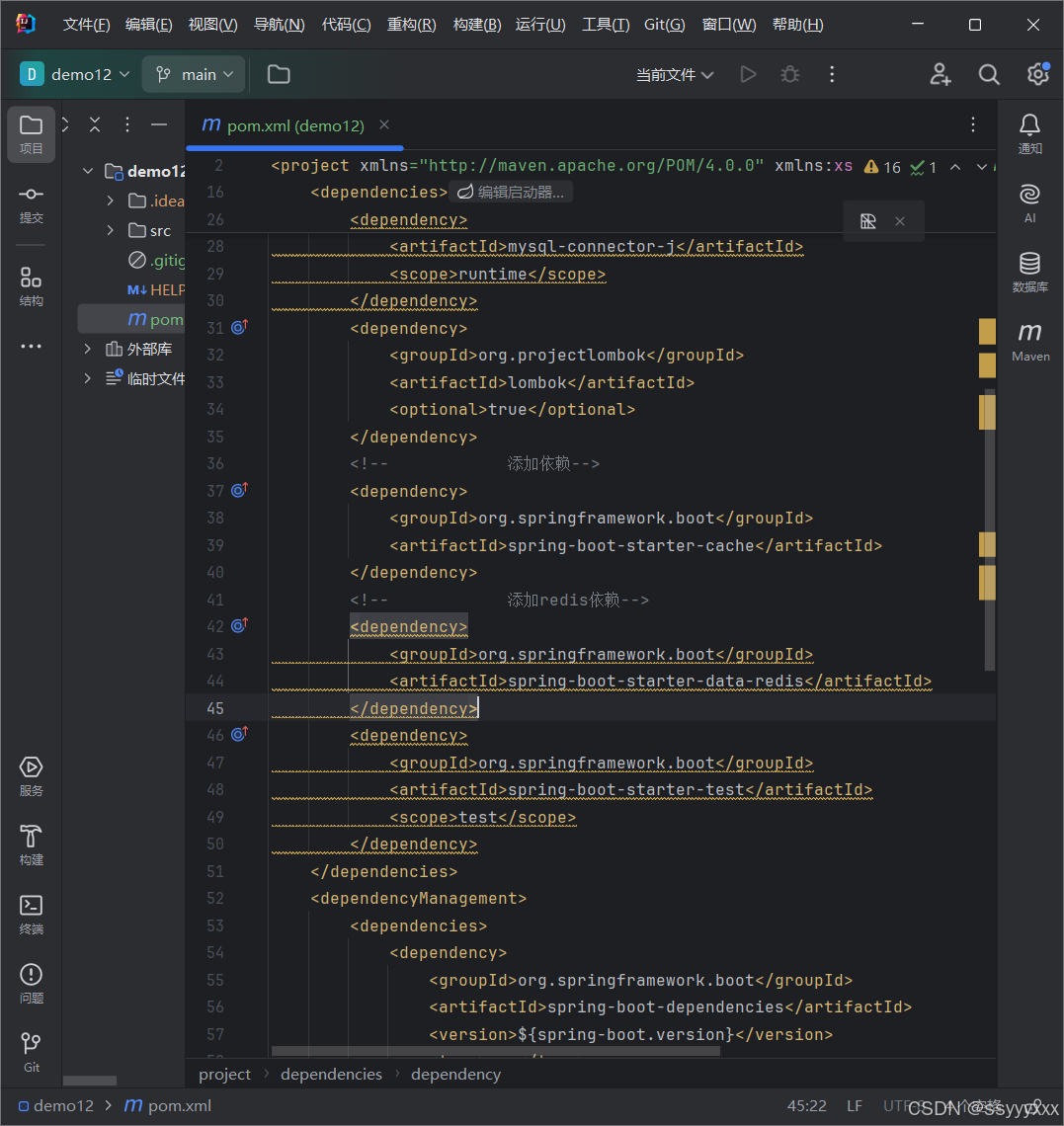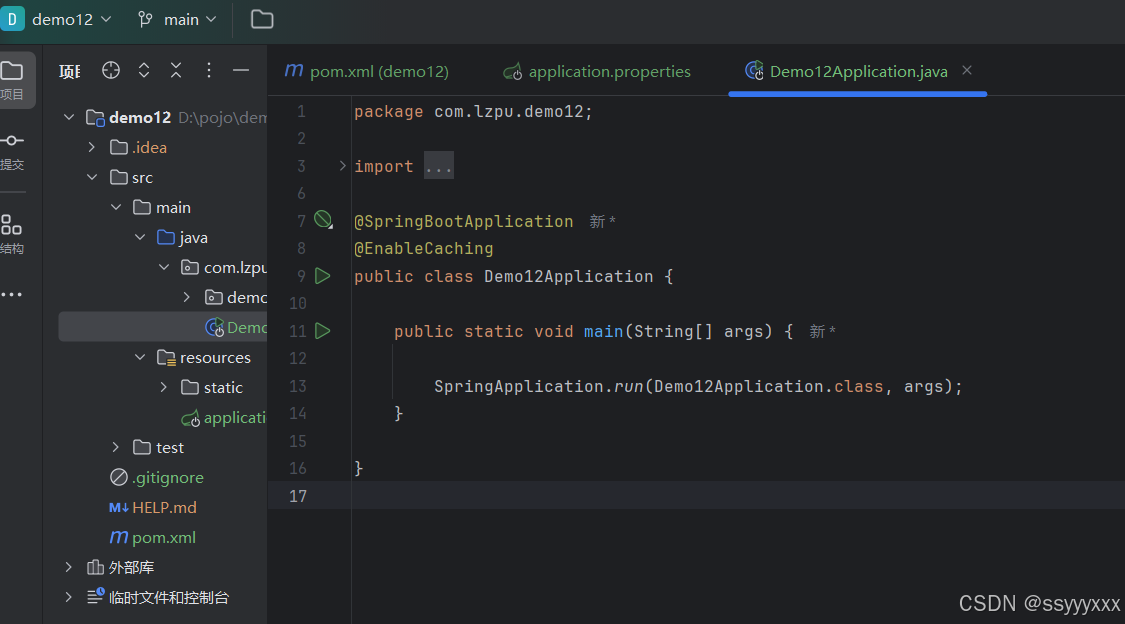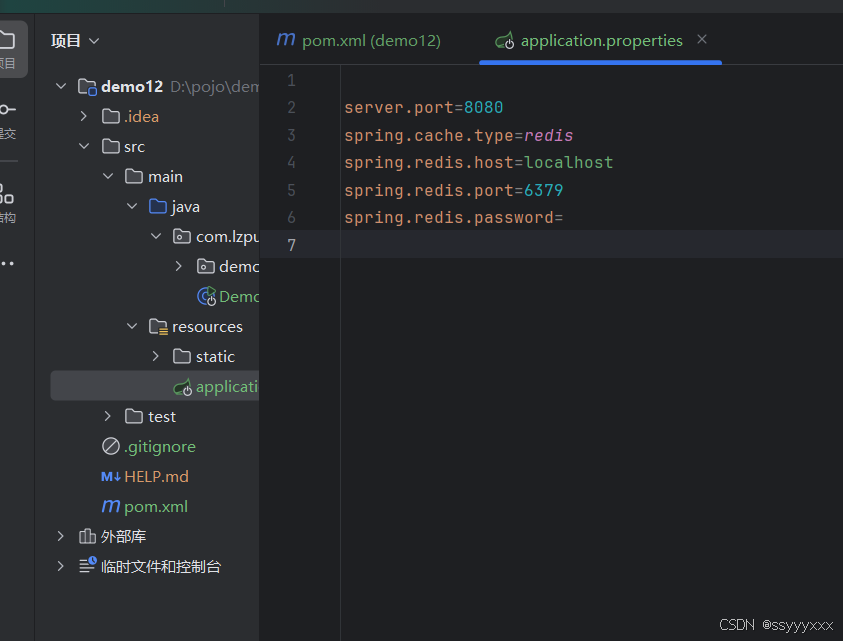在Spring Boot中进行数据缓存管理,可以通过以下步骤实现:
一、添加依赖
1. 首先,需要在项目的pom.xml文件中添加Spring Cache的依赖。Spring Boot提供了一个自动配置模块spring-boot-starter-cache,它会自动配置缓存抽象层,并且支持多种缓存实现,如EHCache、Guava、Redis等。例如:
<dependency> <groupId>org.springframework.boot</groupId> <artifactId>spring-boot-starter-cache</artifactId> </dependency>
2. 如果使用Redis作为缓存,还需要添加Redis的依赖:
<dependency> <groupId>org.springframework.boot</groupId> <artifactId>spring-boot-starter-data-redis</artifactId> </dependency>
如图下:

二、启用缓存
1.在Spring Boot的启动类上添加@EnableCaching注解来启用缓存功能:
@SpringBootApplication @EnableCaching public class Demo12Application { public static void main(String[] args) { SpringApplication.run(Application.class, args); } }
如图下:

三、配置缓存属性
1.在application.properties或application.yml文件中配置缓存相关的属性,例如使用Redis作为缓存时的配置:
spring.cache.type=redis spring.redis.host=localhost spring.redis.port=6379 spring.redis.password=
如图下:

四、使用缓存注解
Spring提供了多种缓存注解,如@Cacheable、@CachePut、@CacheEvict等,可以在方法上使用这些注解来控制缓存的行为。
1.@Cacheable:在方法执行前,会检查缓存中是否有对应的数据,如果有,则直接返回缓存中的数据;如果没有,则执行方法,并将结果存入缓存。
@Cacheable(value = "users", key = "#id") public User getUserById(Long id) { // 从数据库或其他数据源获取用户信息 return userRepository.findById(id); }
2.@CachePut:无论方法执行结果如何,都会将结果存入缓存。通常用于更新操作。
@CachePut(value = "users", key = "#user.id") public User updateUser(User user) { // 更新数据库操作 return userRepository.save(user); }
3.@CacheEvict:用于从缓存中移除数据,可以用于清除缓存。
@CacheEvict(value = "users", key = "#id") public void deleteUser(Long id) { // 删除数据库操作 userRepository.deleteById(id); }
这样,当调用getUserById方法时,Spring Cache会先检查缓存中是否已经存在对应的数据,如果存在则直接返回缓存中的数据,否则会执行方法体中的逻辑,并将结果存入缓存中以供下次使用。
五、自定义缓存管理器
1.如果默认的缓存管理器不能满足需求,可以自定义缓存管理器,例如使用Redis作为缓存管理器。
@Configuration(proxyBeanMethods = false) public class MyRedisCacheManagerConfiguration { @Bean public RedisCacheManagerBuilderCustomizer myRedisCacheManagerBuilderCustomizer() { return (builder) -> builder .withCacheConfiguration("cache1", RedisCacheConfiguration .defaultCacheConfig().entryTtl(Duration.ofSeconds(10))) .withCacheConfiguration("cache2", RedisCacheConfiguration .defaultCacheConfig().entryTtl(Duration.ofMinutes(1))); } }
六、测试缓存
1. 通过访问特定的接口,可以测试缓存是否生效。例如,连续访问同一个查询接口,如果数据库只执行了一次查询,说明缓存已经生效。
七、监控缓存
1.对于生产环境,监控缓存的健康状况和性能是非常重要的。可以使用Spring Boot Actuator来监控缓存的命中率、请求次数等指标。、
八、使用SpEL表达式
在缓存注解中,你可以使用Spring Expression Language (SpEL) 来定义复杂的缓存键。例如,你可以使用方法参数或对象属性来定义缓存键。
Spring Expression Language(SpEL)是一个强大的表达式语言,它支持在运行时查询和操作对象图。在Spring框架中,SpEL被广泛用于各种场景,包括数据绑定、注解处理等。在Spring Cache中,SpEL用于定义缓存键,这允许开发者根据方法的参数或对象的属性动态地生成缓存键。
以下是一些使用SpEL在缓存注解中定义缓存键的例子:
1.使用方法参数作为缓存键
假设你有一个方法,根据用户ID获取用户信息,你可以使用SpEL来定义缓存键,如下所示:
@Cacheable(value = "users", key = "#id") public User findUserById(Long id) { // 数据库查询逻辑 }
2.使用多个方法参数作为缓存键
如果你的方法有多个参数,并且你想使用这些参数的组合作为缓存键,你可以这样做:
@Cacheable(value = "users", key = "#username + '_' + #password") public User findUserByUsernameAndPassword(String username, String password) { // 数据库查询逻辑 }
在这个例子中,#username和#password是方法的参数,SpEL将它们组合成一个字符串作为缓存键。
3.使用对象属性作为缓存键
如果你的方法参数是一个对象,你可以使用对象的属性作为缓存键:
@Cacheable(value = "users", key = "#user.id") public User findUserByUserObject(User user) { // 数据库查询逻辑 }
在这个例子中,#user.id表示User对象的id属性将被用作缓存键。
4.使用复杂的SpEL表达式作为缓存键
SpEL支持非常复杂的表达式,包括方法调用、属性访问、关系运算等。例如,你可以使用SpEL来计算一个哈希值作为缓存键:
@Cacheable(value = "users", key = "T(java.lang.Math).abs(#id)") public User findUserById(Long id) { // 数据库查询逻辑 }
九、配置缓存序列化
1.对于使用Redis等远程缓存的情况,你需要配置序列化和反序列化机制,以确保对象可以正确地存储和检索。
十、数据同步处理
使用@CachePut和@CacheEvict注解来实现缓存数据的同步。例如,更新数据时使用@CachePut来更新缓存,删除数据时使用@CacheEvict来移除缓存中的数据。
1.使用@CachePut更新缓存
@CachePut注解用于在方法执行后更新缓存。当你更新或创建数据时,可以使用@CachePut来确保缓存中的数据是最新的。
@Service public class MyService { // ... 其他方法 ... @CachePut(value = "items", key = "#item.id") public Item updateItem(@NonNull Item item) { // 更新数据库中的记录 return itemRepository.save(item); } }
在这个例子中,updateItem方法在执行数据库更新操作后,会将新的对象item存储在名为items的缓存中,使用item.id作为键。
使用@CacheEvict删除缓存
@CacheEvict注解用于在方法执行后从缓存中移除一个或多个条目。当你删除数据时,可以使用@CacheEvict来确保缓存中的数据被同步删除。
@Service public class MyService { // ... 其他方法 ... @CacheEvict(value = "items", key = "#id") public void deleteItem(Long id) { // 从数据库中删除记录 itemRepository.deleteById(id); } }
在这个例子中,deleteItem方法在执行数据库删除操作后,会从名为items的缓存中移除对应id的条目。
同步多个缓存条目
如果你需要在一次操作中同步多个缓存条目,可以使用@CacheEvict的allEntries属性,或者使用@CachePut的unless属性来条件性更新缓存。
@Service public class MyService { // ... 其他方法 ... @CacheEvict(value = "items", allEntries = true) public void clearCache() { // 清除缓存中的所有条目 } }
在这个例子中,clearCache方法会清除名为items的缓存中的所有条目。
通过上述步骤,可以在Spring Boot中有效地进行数据缓存管理,从而提高应用的性能和用户体验。缓存管理是一个需要持续优化的过程,根据实际业务需求和性能指标来调整缓存策略是非常必要的。























 21万+
21万+

 被折叠的 条评论
为什么被折叠?
被折叠的 条评论
为什么被折叠?








